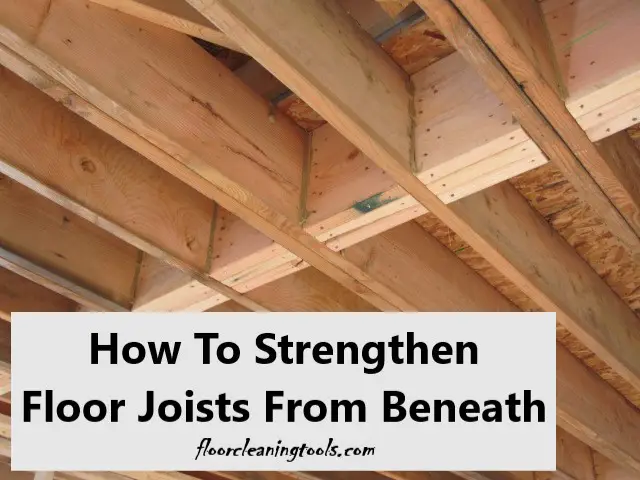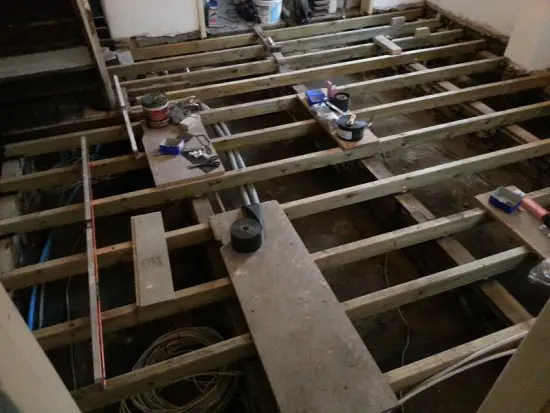What are floor joists exactly? Floor joists support the floors that are not immediately linked to a concrete subfloor. They provide flooring the strength to bear the weight of humans, animals, and many other things in the house.
However, as time passes by, floor joists can lose their supporting strength and may sag or bounce. Because floor joists are difficult to replace, I bet that many of you are craving ways to strengthen floor joists from beneath.
There are various ways to reinforce the floor joists, and each approach has its own set of advantages and disadvantages. In this article, I will share options to reinforce all the floor joists without tearing up your basement.

Table of Contents
What Are The Reasons For Sagging Floor Joists?
Sagging floor joists can be caused by various factors, but based on my experience, most of them revolve around the primary beam that supports the floor joists. The main beam can be carried by a succession of wood supports or posts in older homes. These can decay or become mushy at the bottom, especially if they are buried in concrete.
As wood posts turn soft, part of their stiffness is lost, and they sink. The sinking has an impact on your floor joists where those posts are eventually supporting.
Another reason is floor joists with excessively big cut-outs, for instance, vent pipes, huge plumbing fixtures, or HVAC (heating, ventilation and air conditioning) for different purposes.
In other circumstances, a duct installed through a joist may only preserve a tiny percentage of real floor joist material on both the top and bottom. The floor joist will become unstable since it can no longer sustain the load intended for.
How To Check For Bouncy Floors

Although you notice that your floors are excessively bouncy, I advise you should first check them to determine whether they need repairing or not. But before you descend your basement and make any major decisions, you should know what to inspect.
Here are some things I recommend you should do while examining your bouncy flooring:
- Inspect your joists for damage and ensure they’re all in good shape.
- Check for the rot with a screwdriver. The joist has to be repaired if the wood is soft, and you can fix it with a screwdriver.
- Examine the joist-supporting beams and posts.
- Look for signs of degradation.
To make sure your joists are the right size, measure them and verify their spans.
How To Strengthen Floor Joists From Beneath
Bridging
What is bridging? Let me explain briefly what bridging is. Bridging is bringing the floor closer together and distributes the pressure equally across the floor joists.
However, if you are experiencing drooping floors, it may be because the previously constructed bridging is lax on floor joists that had bridging done on them previously. Still, instead of repairing it, I think you only need to strengthen it by nailing it.
My recommendation is that you install your new bridging at about 1/3 intervals based on your floor joists’ length.
Meanwhile, for bridging, I often use metal floor joists to bridge over your old wood blocking for longer floor joists. This is because the metal type bridging does not interfere with the electrical and plumbing, unlike solid blocking.
To build a bridge, I first measure the width of the space between two joists and then cut planks to fit. Usually, I have to use a 2×6 plank. Next, I use a 3.5 inches long nail to secure a cut wood between the joists and remember to rep on all joists on the floor.
Increasing The Wood Layer
Adding a new layer of plywood beneath the floor joists is another efficient technique to support them below. Based on my experience, shorter and lighter plywood strips are the best option for this repair since they’re more flexible, making installation quick and uncomplicated.
For me, the optimal length and thickness for your plywood strips are 8 feet long and ¾ inch thick.
While adding the wood layers, I always guarantee maximum stickiness between the joists’ bottom and the plywood I will screw in for this technique to work. Then, I start by sanding the joists’ underside with 80 grits of sandpaper to prepare them.
Sistering Floor Joists
Sistering is about doubling or tripling your floor joists, and it is recommended for skilled people only. Here are the needed steps:
#Step one: you need to choose a sistering material that is the same size as the previously reinforced joists. Refined timber or engineered wood are two popular options for this material.
#Step two: Put on your safety gear, including helmets, earplugs, goggles, and boots.
#Step three: Before installing, re-align and correct the sinking floor. Use a hydraulic floor jack to construct a 4×4 inches post and repeat it until the formed post and floor joists reach each other. This is to limit any fractures during the joist sistering process.
#Step four: Apply an appropriate adhesive to the joists’ whole length to ensure new joists are securely fastened to the old ones to make a well-bonded sistering.
#Step five: Install sister joists on top of the 4×4 inches post you built earlier.
#Step six: Nail the new joists to the old ones to make sure they’re connected. You can clamp the floor joists in place during nailing but remember to remove the clamps when you’re finished.
Conclusion
Can you now strengthen floor Joists from beneath? Is it easier since you have already read through our instructions? Don’t be afraid to try it out, as these are all simple methods. You can also share your experience with me in the comment section below.
Best of luck with your work. Thank you for reading.
Related Post:
- Pros And Cons Of Fiber Mesh Concrete: Is It the Future of Building?
- Staining Maple Floor – How to Stain Maple Floors Properly
- Best Type Of Flooring For An Unheated Sunroom – Which One Will Suit You?
- How To Refinish Terrazzo Floors And Polish Them
